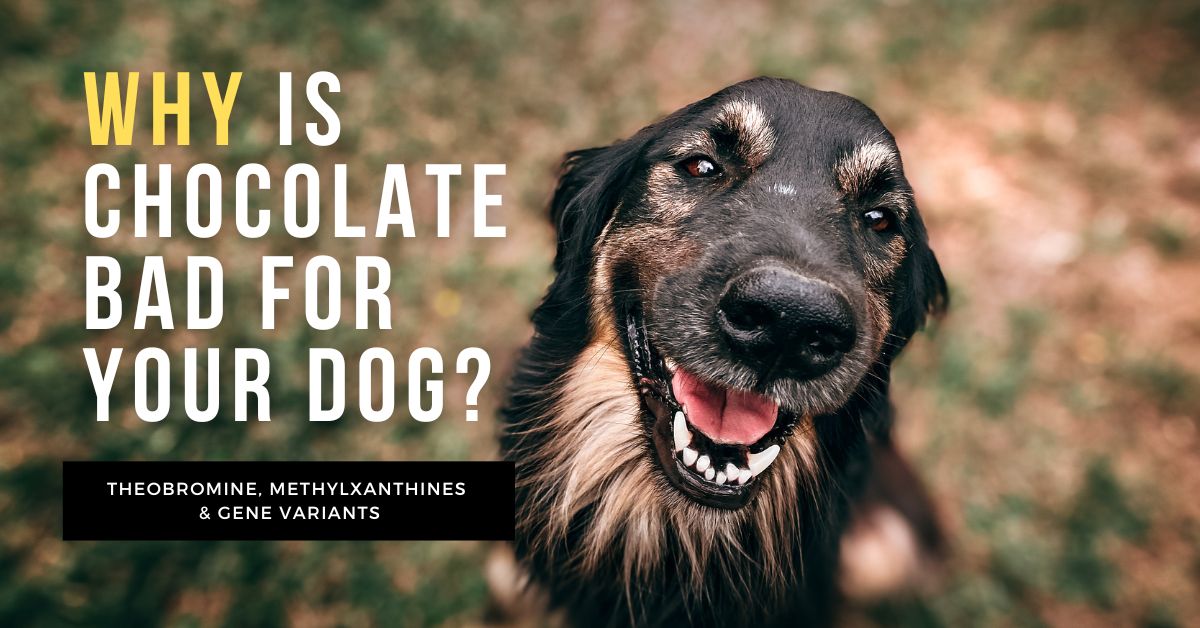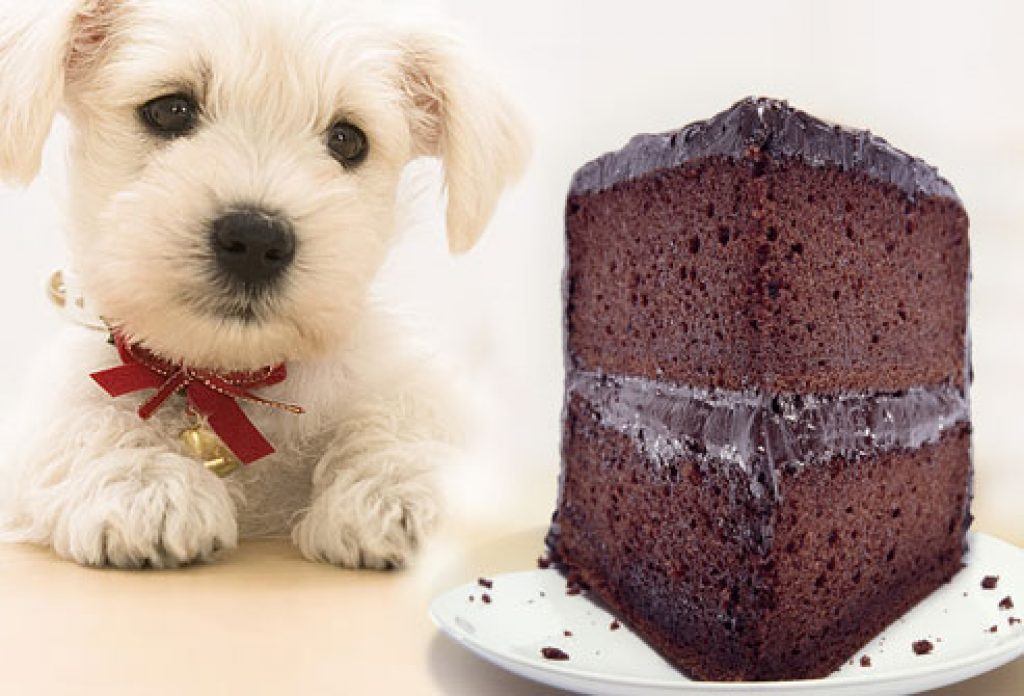Why is chocolate bad for a dog?

I’m sure you’ve heard chocolate is bad for dogs, but why is it bad for dogs?
You may wonder why chocolate is fine for us to eat, but so potentially harmful for your dog. The reason is chocolate contains theobromine, and also caffeine, which your dog cannot effectively metabolise.
You may be surprised to learn not all dogs are affected, or at least not affected to the same extent. Gene variants play a part in this, which I’ll discuss shortly.
We’ll take a look at the science behind chocolate being bad for dogs, and also the reasons why different kinds of chocolate may be more harmful than others.
- Why is chocolate bad for dogs?
- How much chocolate will harm a dog?
- What types of chocolate are the most dangerous?
- What are the signs and symptoms of chocolate poisoning in dogs?
- What to do if your dog eats chocolate?
- Prevention is always the best policy
- Never reward your dog with chocolate
- Last, but by no means an oversight – Is chocolate bad for cats?
Why is chocolate bad for dogs?
Dogs who are most at risk of chocolate toxicity are those with a variant in a specific gene. This is the CYP1A2 gene, and the variant is known as 1117C>T.
The CYP1A2 gene is primarily involved in the metabolism of various substances, including drugs and toxins. The 1117C>T variant represents a change from a cytosine (C) to a thymine (T) at position 1117 in the gene’s sequence.
It’s such a small variant, but this is associated with an altered drug and toxin metabolism, and also a susceptibility to certain diseases.
That’s the guts of the science out of the way, and I hope I haven’t lost you already. Bare with me, and I’ll tell you what this means.
Chocolate contains an alkaloid known as theobromine, which is the most harmful part of chocolate (and cocoa).
Chocolate also contains caffeine.

Theobromine and caffeine are in a group of chemicals known as methylxanthines. We metabolise these chemicals more effectively than dogs, and because our dogs can’t metabolise them effectively they become toxic.
To go one step further, methylxanthines as stimulants prevent adenosine receptors activating. These receptors have a number of important functions, and are key in regulating sleep and letting us rest. They also help regulate the heart by controlling oxygen and blood flow. We tolerate this better than our dogs, which is why it can be much more severe for them than us.
For a dog, consumption of chocolate can cause nausea, increased heart rate, or to a more severe extent tremors, seizures, or death.
There’s a more conclusive list of symptoms below, but if your dog has digested chocolate, especially dark chocolate, cocoa, or baking chocolate, it is better to be safe and speak with your vet.
How much chocolate will harm a dog?
Some dogs have been known to consume chocolate with no ill effects, but as a general rule any chocolate can cause sickness. Sometimes you may not recognise the symptoms until it’s too late.
It’s therefore better to make sure your dog never comes into contact with chocolate, so take precautions – especially around Easter and Christmas, and around children. Dogs are scavengers, they don’t know any better, and they will eat chocolate given the chance.
Let’s consider a general rule. This may be used by your vet to determine severity, or if they see a need to administer something like apomorphine hydrochloride to cause your dog to vomit up as much chocolate as possible.
Theobromine in chocolate is toxic to a dog when it ingests between 100 and 150 milligrams per kilogram of body weight.
If your dog snatches a biscuit with the odd chocolate drop then you won’t likely see any ill effects, but it may still pose a risk.
Anything more than that, be on alert.
What types of chocolate are the most dangerous?
All chocolate is bad for your dog, and unnecessary, but dark chocolate, baking chocolate, and cocoa contain the highest amounts of theobromine and are a more significant risk to your dog.
Quantity is also a factor, as is the size of your dog.
For example, it may take 500g of milk chocolate to poison a 10kg dog, but only 50g of baker’s chocolate or 150g of semi-sweet chocolate.
Keep in mind even a small amount of any chocolate may harm your dog.
It’s easy for a sneaky dog to get into something like an Easter basket full of chocolate eggs and bunnies and gobble up half a kilo or more in no time. I’m sure you know how determined your dog can be when it comes to food? Foil wrapping isn’t much of a deterrent.
That amount of chocolate could well be deadly.
Most dog owners know chocolate is toxic, but keep in mind it’s the quantity and type of chocolate that can make the difference between a bit of sickness and severe illness.
A simple rule of thumb is this – never give your dog chocolate. Your dog doesn’t need sugary treats of any kind.
What are the signs and symptoms of chocolate poisoning in dogs?
Usually the first symptoms of chocolate toxicity are retching, vomiting, or irritability, but any of the symptoms below should be considered reasons to call your vet immediately:
- Hyper excitability
- Hyper irritability
- Increased heart rate
- Restlessness
- Increased urination
- Muscle tremors
- Vomiting
- Diarrhea
If your dog has eaten chocolate, and especially if your dog is displaying any of those symptoms, then the time to act is now.

What to do if your dog eats chocolate?
If your dog eats chocolate, particularly in excess, then immediately call your veterinarian.
Your vet will ask you how much chocolate your dog has consumed, what kind, and when. They will also ask what symptoms your dog is displaying. Offer them all the information you can.
Your vet will recommend an immediate course of action, but if your dog has consumed excess chocolate (particularly dark chocolate, baking chocolate, or cocoa), then you may need to take your dog immediately to the vet.
The course of action your vet will take is dependent on the dose of theobromine they suspect your dog has consumed. They may induce vomiting, use IV fluids, appropriate medicine (such as anti-seizure or potentially heart failure drugs).
Most dogs can recover within 2 to 3 days after treatment for theobromine poisoning from chocolate, but never take any chances.
Prevention is always the best policy
As dog owners we must be diligent, and their health is our responsibility. The below bullet points may sound like common sense, but it’s good to consider them thoroughly:
- Keep all chocolate stored securely, in a cupboard, out of reach from your dog. If you have kids, make sure they are responsible with chocolate and do not leave it lying around (having a kid myself I know this is easier said than done).
- Inform all family members (and guests) about the dangers of chocolate to pets. Children will need reminding of this regularly, as it’s difficult for them to understand the consequences.
- Be particularly careful during holidays like Easter and Christmas, or when friends are over for dinner. Especially when drinking! During these events, such as Christmas dinner, it may be better to keep your dog safe in a separate room – for their own benefit.
Never reward your dog with chocolate
You should never give chocolate in any form to your dog. There is absolutely no need, and a healthy and balanced food such as meat (i.e. boiled chicken breast) is more a treat for your dog than chocolate will ever be.
Your dog will also respond to verbal encouragement with lots of love and attention more than they would chocolate.
Last, but by no means an oversight – Is chocolate bad for cats?
I felt I should cover this too, but you may have guessed already that chocolate is just as bad for our cats as it is for our dogs.
We’ve often told dogs are omnivores like us, and cats are obligate carnivores like their alien ancestors, but the truth is our dogs are much more similar to cats than us. Their digestive systems, diet, and instinct is very similar in fact, as are the risks to their health from inappropriate foods like chocolate.
Chocolate will cause the same symptoms of toxicity in a cat, and may also cause death. Thankfully our cats are much more sensible about what they put in their mouths and eat, but it is still worth being careful.
I hope that thoroughly answers the question why chocolate is bad for dogs. Perhaps it’s a reason for us to stop eating chocolate as well. I know I’ve been trying (and failing) for decades…






I recently saw an info graphic on Facebook by a company called Petcarerx that talked about chocolate poisoning in dogs. Xylitol was another one present in the list of ingredients toxic to dogs. Many dog parents do not realize that xylitol is often present in sugar-free peanut butter. They should be aware off these common human foods that are poisonous to their dogs.